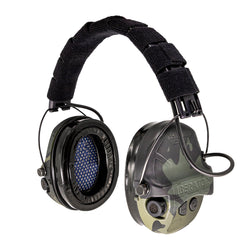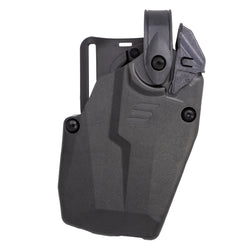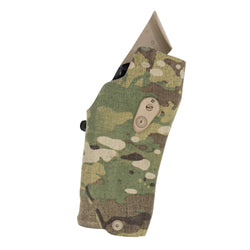One of the most trusted weapon-mounted lights (WML) of all time is the Streamlight TLR-1. It was designed for civilians, law enforcement, and military personnel. I carried the original TLR-1 at work for more than a decade before upgrading to the TLR-1 HL, and now we have the even newer TLR-1 HL-X.
I trust it because of my own experience and some of the things I’ve seen the light hold up to. But is the new TLR-1 HL-X reliable?
Streamlight’s New TLR-1 HL-X
I’ve been a big fan of the TLR-1 light for years. But I have also learned the hard way not to assume newer versions are made of the same quality. For me to believe it and trust it, I want to see it for myself.
While time is the real test for any product, I like to perform my own little tests right off the bat to see how a new light holds up. I’ll go over these tests in just a moment.
This new light introduces several features that make it a solid upgrade from previous TLR-1 models. Just about every aspect of the classic design has been improved.

Here are the three main differences between the HL-X and older versions:
Front-loading batteries
One thing I have never cared for with the TLR-1 light is how the batteries are installed—you have to remove the light from the gun to change them. It’s not a huge deal most of the time, but if you are in a hurry, it’s not ideal.
The new TLR-1 HL-X fixes that. You can now swing the front of the light open to expose the battery compartment. This is done by pushing a button on one side while flipping a lever on the other.

I like this design because you don’t have to worry about the front of the light swinging open by mistake.
Paddle switch instead of a toggle switch
The next thing that has been upgraded with this light is how you activate it. I didn’t mind the original toggle switch on the earlier models of the TLR-1 light, but I welcome this upgrade.

With the toggle-switch system, you pushed the toggle to the left for momentary light and to the right for constant on. I like the paddle switch design a little more because it’s the same on both sides. Push either paddle switch down momentarily, and the light will turn off when you let go. Push it down quickly, and it will stay on.
Rechargeable batteries
The rechargeable batteries are another noticeable upgrade with the TLR-1 HL-X. Like the older models, it runs on two CR123A batteries, a common battery for weapon-mounted lights and they’re not expensive. But a rechargeable pair that comes with the light is still a great feature. If they run down in the field, you can still throw a standard set of batteries in it.
What else is different on the TLR-1 HL-X?
Aside from the upgrades mentioned above, the TLR-1 HL-X offers 1,500 lumens and a run time of 1.5 hours compared to the older TLR-1 HL, which has 1,000 lumens. It also has a water rating of IPX7.
When it comes to the quick-mount dial, Streamlight removed the little raised edges that helped you tighten it by hand. I know this may not be as important now because you can change the batteries without removing the light, but I kind of liked the old one better.

As it is now, I can attach the light by hand, but if I want to make sure it’s securely tightened to the gun, some type of small tool is needed. A flat screwdriver, penny, knife, or anything like that would work.
TLR-1 HL-X Specifications
- Lumens: 1,500
- Peak Beam Intensity: 20,000 candela
- Run Time: 1.5 hours
- Battery Type: Two CR123A lithium batteries
- Weight: 4.4 oz
- Length: 3.39 inches
- Water Resistance: IPX7 (submersible up to 1 meter for 30 minutes)
- Material: 6000 Series aircraft aluminum
- Mounting System: Rail clamp system for quick attachment/detachment
Holster compatibility
For the most part, the new TLR-1 HL-X is about the same size as the older models. This means you can use your same holster setup as you did with the TLR-1 HL.
I’ve found that some holsters made for the original TLR-1 fit a little tight with the TLR-1 HL. Holsters made for the TLR-1 HL-X should fit without issue and might even work in a holster designed for the original TLR-1.

I tested the new Streamlight out in multiple Safariland holsters and found it worked great in the ones I had. This was with a Glock 19 and 17 and a Walther PDP.
Putting the TLR-1 HL-X to the test
Nothing tests a product like use and time. That’s what separates true quality from lower-grade gear. Take the Trijicon ACOG, for example—its long history proves its durability on battlefields, in training centers, and beyond. It continues to perform in the field today.
The challenge with new products is figuring out how to put some real stress on them in a short amount of time. My tests can’t match what years of use reveal, but they do give a solid first look at a product’s durability.
Replicating the elements
With most optics I review, I like to toss them in the freezer overnight, soak them in water, and even bake them in the oven. I’ve put the TLR-1 and TLR-1 HL through all of this without a single issue. So it was no surprise that the TLR-1 HL-X held up just as well.
I left it in a 5-gallon bucket of water for about three hours and found no apparent leaks. After that, I put it in the oven at 150 degrees for an hour. A car can often get hotter than this, but it still gives a solid idea of how the light will handle heat.
Note: Do not try this at home. Placing batteries in an oven or any type of extreme heat can be dangerous without taking proper precautions first. It can also damage the product beyond repair or void the warranty.

Once those tests were done, I left the light in the freezer overnight. When I turned it on the next morning, it was noticeably dimmer, but the brightness returned as it warmed up. My freezer is set to -12 degrees, so it’s not the coldest temperatures someone might encounter, but it’s a solid starting point.
Impact testing
When possible, I try to do this test without scratching the heck out of the product. Some people like to throw things out of windows or drive them over with their monster truck, but I like to stick to simpler tests. For me, it’s a mallet and a wooden floor.
I dropped the light while attached to my unloaded Glock 17 onto a wooden deck multiple times. This was done from shoulder height, as this is about as far as I’ve ever dropped anything in real life.
After that, I smacked it with a rubber mallet multiple times to see if anything would come loose or stop working. The light continued to operate as it should during these tests.
Streamlight TLR-1 HL-X Range Performance
Have you noticed that some firearms accessories tend to break, come loose, or fall off when you’re at the range? It’s like a magic trick happens when you chamber live ammo and start shooting. I’ve tightened gear beforehand, only to have it come loose after I start my training.
Thanks to AmmoToGo.com, we were able to put about 300 rounds of Federal 9mm 115 grain ammo down range with the TLR-1 HL-X attached to a Glock 17.
This doesn’t replicate 1,000 rounds or more, but I wanted to check for any obvious issues with the clamp on the light. During our range time, we also ran a lot of drills that required holstering and unholstering the gun.

I’ve had a light come loose before during holster drills before, even when I wasn’t shooting the gun. That ended up being a specific issue with that particular light, but it shows how much wear gear takes just from repeated holstering. By the end of the range day, I had no issues with this light—it continues to run exactly as it should.
TLR-1 HL-X: A Solid Upgrade
The TLR-1 HL-X is by far my favorite WML from Streamlight. It’s a fantastic upgrade to a light I already respected from my own field use.
The front-loading battery system is the best update they could have made, and I also like the ambidextrous paddle switches. The 1,500 lumen output is another welcome improvement. This light appears to be just as durable as the older versions, which have been proven in the field for years.
The TLR-1 HL-X currently retails for around $190-$220, depending on where you buy it. That’ price is not bad when you compare’s a fair price compared to other high-end lights on the market.
If you already have a TLR-1 HL and don’t mind the rear-loading battery design, you may not need to upgrade. But if you are looking for a new light, this is a great one to check out.











